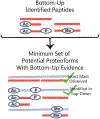Improving Proteoform Identifications in Complex Systems Through Integration of Bottom-Up and Top-Down Data
- PMID: 32584579
- PMCID: PMC7490796
- DOI: 10.1021/acs.jproteome.0c00332
Improving Proteoform Identifications in Complex Systems Through Integration of Bottom-Up and Top-Down Data
Abstract
Cellular functions are performed by a vast and diverse set of proteoforms. Proteoforms are the specific forms of proteins produced as a result of genetic variations, RNA splicing, and post-translational modifications (PTMs). Top-down mass spectrometric analysis of intact proteins enables proteoform identification, including proteoforms derived from sequence cleavage events or harboring multiple PTMs. In contrast, bottom-up proteomics identifies peptides, which necessitates protein inference and does not yield proteoform identifications. We seek here to exploit the synergies between these two data types to improve the quality and depth of the overall proteomic analysis. To this end, we automated the large-scale integration of results from multiprotease bottom-up and top-down analyses in the software program Proteoform Suite and applied it to the analysis of proteoforms from the human Jurkat T lymphocyte cell line. We implemented the recently developed proteoform-level classification scheme for top-down tandem mass spectrometry (MS/MS) identifications in Proteoform Suite, which enables users to observe the level and type of ambiguity for each proteoform identification, including which of the ambiguous proteoform identifications are supported by bottom-up-level evidence. We used Proteoform Suite to find instances where top-down identifications aid in protein inference from bottom-up analysis and conversely where bottom-up peptide identifications aid in proteoform PTM localization. We also show the use of bottom-up data to infer proteoform candidates potentially present in the sample, allowing confirmation of such proteoform candidates by intact-mass analysis of MS1 spectra. The implementation of these capabilities in the freely available software program Proteoform Suite enables users to integrate large-scale top-down and bottom-up data sets and to utilize the synergies between them to improve and extend the proteomic analysis.
Keywords: bottom-up proteomics; post-translational modification; protein inference; proteoforms; software; top-down proteomics.
Conflict of interest statement
The authors declare no competing financial interests.
Figures








Similar articles
-
Proteoform Analysis and Construction of Proteoform Families in Proteoform Suite.Methods Mol Biol. 2022;2500:67-81. doi: 10.1007/978-1-0716-2325-1_7. Methods Mol Biol. 2022. PMID: 35657588 Free PMC article.
-
Expanding Proteoform Identifications in Top-Down Proteomic Analyses by Constructing Proteoform Families.Anal Chem. 2018 Jan 16;90(2):1325-1333. doi: 10.1021/acs.analchem.7b04221. Epub 2017 Dec 22. Anal Chem. 2018. PMID: 29227670 Free PMC article.
-
Constructing Human Proteoform Families Using Intact-Mass and Top-Down Proteomics with a Multi-Protease Global Post-Translational Modification Discovery Database.J Proteome Res. 2019 Oct 4;18(10):3671-3680. doi: 10.1021/acs.jproteome.9b00339. Epub 2019 Sep 18. J Proteome Res. 2019. PMID: 31479276 Free PMC article.
-
High-throughput quantitative top-down proteomics.Mol Omics. 2020 Apr 1;16(2):91-99. doi: 10.1039/c9mo00154a. Epub 2020 Jan 14. Mol Omics. 2020. PMID: 31932818 Free PMC article. Review.
-
Top-Down Proteomics and the Challenges of True Proteoform Characterization.J Proteome Res. 2023 Dec 1;22(12):3663-3675. doi: 10.1021/acs.jproteome.3c00416. Epub 2023 Nov 8. J Proteome Res. 2023. PMID: 37937372 Free PMC article. Review.
Cited by
-
Small Extracellular Vesicle (sEV) Uptake from Lung Adenocarcinoma and Squamous Cell Carcinoma Alters T-Cell Cytokine Expression and Modulates Protein Profiles in sEV Biogenesis.Proteomes. 2025 Apr 23;13(2):15. doi: 10.3390/proteomes13020015. Proteomes. 2025. PMID: 40407494 Free PMC article.
-
Proteomics Standards Initiative's ProForma 2.0: Unifying the Encoding of Proteoforms and Peptidoforms.J Proteome Res. 2022 Apr 1;21(4):1189-1195. doi: 10.1021/acs.jproteome.1c00771. Epub 2022 Mar 15. J Proteome Res. 2022. PMID: 35290070 Free PMC article.
-
Mass Spectrometry-Based Proteomic Technology and Its Application to Study Skeletal Muscle Cell Biology.Cells. 2023 Nov 1;12(21):2560. doi: 10.3390/cells12212560. Cells. 2023. PMID: 37947638 Free PMC article. Review.
-
Identification of Inflammatory Proteomics Networks of Toll-like Receptor 4 through Immunoprecipitation-Based Chemical Cross-Linking Proteomics.Proteomes. 2022 Sep 1;10(3):31. doi: 10.3390/proteomes10030031. Proteomes. 2022. PMID: 36136309 Free PMC article.
-
How Can Proteomics Help to Elucidate the Pathophysiological Crosstalk in Muscular Dystrophy and Associated Multi-System Dysfunction?Proteomes. 2024 Jan 16;12(1):4. doi: 10.3390/proteomes12010004. Proteomes. 2024. PMID: 38250815 Free PMC article.
References
-
- Yang X; Coulombe-Huntington J; Kang S; Sheynkman GM; Hao T; Richardson A; Sun S; Yang F; Shen YA; Murray RR; Spirohn K; Begg BE; Duran-Frigola M; MacWilliams A; Pevzner SJ; Zhong Q; Trigg SA; Tam S; Ghamsari L; Sahni N; Yi S; Rodriguez MD; Balcha D; Tan G; Costanzo M; Andrews B; Boone C; Zhou XJ; Salehi-Ashtiani K; Charloteaux B; Chen AA; Calderwood MA; Aloy P; Roth FP; Hill DE; Iakoucheva LM; Xia Y; Vidal M, Widespread Expansion of Protein Interaction Capabilities by Alternative Splicing. Cell 2016, 164, (4), 805–17. - PMC - PubMed
Publication types
MeSH terms
Substances
Grants and funding
LinkOut - more resources
Full Text Sources
Miscellaneous

